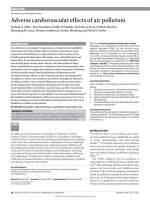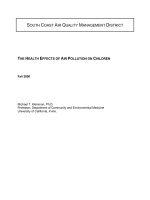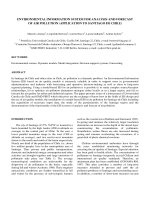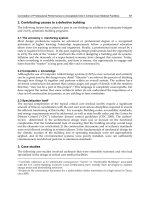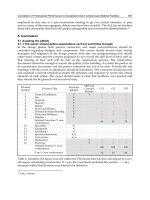Monitoring Control and Effects of Air Pollution Part 10 pdf
Bạn đang xem bản rút gọn của tài liệu. Xem và tải ngay bản đầy đủ của tài liệu tại đây (8.41 MB, 20 trang )
Air Pollution and Cultural Heritage: Searching for “The Relation Between Cause and Effect”
171
4.2.2.4 Characterization of cultural heritage deterioration by means of XRD, SEM and
Raman analysis
Fig. 8. XRD-diagram for the L351 statue from the interior of the Museum of Kavala: (on the
top) before the injection of gaseous pollutants and (at the bottom) after the injection of
gaseous pollutants.
Monitoring, Control and Effects of Air Pollution
172
The characterization of the above-mentioned cultural heritage materials through diffraction
(XRD), spectroscopic (Raman) and microscopy techniques (SEM) was achieved following to
the RF-IGC experiments. For example, the XRD-analysis for the L351 statue from the interior
of the Museum of Kavala showed that it is a marble mostly composed of dolomite and quite
less of calcite; the opposite stands for the L291 statue from the exterior of the same Museum.
As it can also be revealed from the XRD-analysis (c.f. Fig. 8), some gypsum was detected
before the exposure of the statue sample to the gaseous pollutants, so either the gypsum was
a minor component of the marble or it was formed during a previous exposure of the statue
to an atmosphere that permitted this formation. After the exposure to the pollutants, no
gypsum was detected by any method used. This is rather expected because there was no
humidity during the contact of the injected sulphur dioxide onto the marble. More, an
improvement in the organization of the crystallites of the sample is observed after the
injection of the gaseous pollutants. In the Raman spectra (c.f. Fig. 9) for the same statue after
the exposure an accumulation of weak peaks at 1970-2200 cm
-1
is distinguished owing to
acetylene (C
2
H
2
). More, the main peak existed in 1095 cm
-1
, before the exposure to the
gaseous pollutants, which concerns the carbonate ion, is absent in the spectrum after the
injection of the pollutants. The SEM-images for both statues (L351: dolomite and L1991:
calcite) are shown in Fig. 10, where is evident the coarse and porous structure of dolomite.
Calcite seems more tight and compact. The combination of Raman and SEM-EDAX analysis
showed that SO
2
was adsorbed (Metaxa et al., 2009b).
Fig. 9. Raman-spectra for the L351 statue from the interior of the Museum of Kavala: (on the
top) before the injection of gaseous pollutants and (at the bottom) after the injection of
gaseous pollutants.
L351 STATUE OF KAVALA: AFTER
L351 STATUE OF KAVALA: BEFORE
Air Pollution and Cultural Heritage: Searching for “The Relation Between Cause and Effect”
173
Fig. 10. SEM-images showing the shapes of calcite (on the top) and dolomite (at the bottom).
Monitoring, Control and Effects of Air Pollution
174
4.2.2.5 Extracting information about surface heterogeneity
The “non-ideal” behavior of a solid surface in the direction of the adsorption of a gaseous
substance on it consists of an inherent energetic heterogeneity component and an
adsorption-induced heterogeneity component originated from the lateral interactions
between the adspecies. Surface heterogeneity is responsible for the time-variation in the
activation of the various active sites onto the solid surface towards the adsorption process.
The effects of surface heterogeneity on adsorption equilibrium have extensively studied,
both experimentally and theoretically. The RF-IGC methodology constantly answers for the
role of surface heterogeneity on the adsorption phenomena, through the local
physicochemical quantities determined for various adsorption systems. The results obtained
are in a good agreement with literature data as it has already been shown (Metaxa et al.,
2009a).
4.2.2.6 Study of the action of sulfur dioxide on Penteli marble in the presence or the
absence of protective materials-evaluation of the effectiveness of the protective materials
for monuments against sulfur dioxide corrosion
Calcareous stones, such as marble, suffer from the attack of sulfur dioxide in polluted
atmospheres because of the transformation of calcite-content (CaCO
3
) into gypsum
(CaSO
4
·2H
2
O) as final product [Elgohary, 2008]. The choice of the repair materials is a
crucial point in stone conservation. Such operations, in fact, are much critical, as they can
alter the structure of the original material and create new textural heterogeneity at the
natural stone-composite interface. In order to avoid unsuccessfully results, the
characteristics of materials used in conservation works and their compatibility, including
long-term effects, with existing materials should be fully established. Thus, new
impregnation products, as well as those which already exist, must be viewed with caution
and be subjected to laboratory research before they applied on historic buildings. The choice
between “traditional” and “innovative” materials and techniques should be determined
case-by-case with preference given to those that are least invasive and most compatible with
heritage values, consistent with the need for safety and durability.
Protective materials, such as acrylic copolymers and siloxanes, have been largely used in
conservation practice as coatings, consolidants and adhesives, because of their good
adhesion, film forming properties and their environmental stability. These materials alter
the physicostructural properties of the porous materials and change the physicochemical
behavior of the interface between the work of art and the environment [Carreti & Dei, 2004].
Therefore, the characterization of the solid surfaces before and after the application of these
materials is important for the evaluation of their ability to protect the historic monuments
and buildings.
In order to study the action of SO
2
on Penteli marble, experiments were carried out by using
the RF-IGC instrumentation and various physicochemical parameters (rate constants as well
as equilibrium constants) were calculating by using a non-linear regression analysis PC-
programs in GW-BASIC [Katsanos et al., 2003] for the experimental data. Afterwards,
kinetic parameters such as adsorption rate constants k
1
, adsorption/desorption k
R
and
surface reaction rate constants k
2
, as well as surface diffusion coefficients D
y
, deposition
velocities V
d
and reaction probabilities γ of SO
2
“on marble surfaces, at various
temperatures,” in the presence or in the absence of protective materials (an acrylic
copolymer, Paraloid B-72 or a siloxane, CTS Silo 111) were calculated and discussed
Air Pollution and Cultural Heritage: Searching for “The Relation Between Cause and Effect”
175
[Bakaoukas et al., 2005]. The results showed that both materials are good enough at low
temperatures (303.2-323.2K), while at high temperatures (333.2-353.2K) siloxane acts better
as protective material than acrylic copolymer. More specifically, the values of surface
reaction rate constant k
2
in all cases where the marble was coated by the acrylic copolymer
were bigger than those for pure marble, while they were smaller in all cases where the
siloxane was used as protective material. Probably that happens because SO
2
interacts with
the acrylic copolymer and not with the siloxane and a mechanism was proposed for this
interaction. On the other hand, the values of the adsorption rate constant k
1
for the system
(SO
2
+ marble) were bigger than those for the systems (SO
2
+ coated marble), thus indicating
that the adsorption of SO
2
is more difficult in the case of coated marble than in the pure
marble. In addition, the values of V
d
and γ in most cases where the marble was coated with
anyone of the protective materials were smaller than those for pure marble, except from the
higher temperature of 353.2K where the differences before and after coating with the acrylic
copolymer were negligible; probably, because in this high temperature SO
2
interacts more
rapidly with the acrylic copolymer. Concerning the effect of coatings on D
y
-values, it was
found that in the absence of protective materials, at extreme temperatures (>333.2K), the
porous of the marble is being destroyed producing surface diffusion coefficients equivalent
to diffusion coefficients in the gas phase. On the contrary, in the presence of protective
materials, the later does not happen due to the shrink of the porous size of the marble[Bird
et al., 2002; Carreti & Dei, 2004; Bakaoukas et al., 2005].
5. Conclusions
Among the various causes which are responsible for the destruction of cultural property,
namely of historic artifacts and monuments, air pollution could be considered as an
important one. Cultural goods are chiefly significant as a kind of evidence of past human
activity. Conservation of cultural heritage allows this evidence to be consulted whenever
new questions about the past are emerged. Thus it is well-understood that successful
conservation has to be underpinned by a comprehensive understanding of the causes of
decay and the factors controlling them.
In order to estimate the impacts of air pollution on the various solid surfaces, including
them of cultural heritage, in a real scientific basis, theory and experiment needs to cooperate
in a way close to real systems. From this aspect of view, the new dynamic version of classic
inverse gas chromatography, the so-called Reversed-Flow Inverse Chromatography (RF-
IGC), combining a powerful mathematical background with a very simple and smart
experimental arrangement, attains this purpose by using time-resolved analysis in the way
this method has developed it. Thus, by means of a simple PC-program, important local
physicochemical quantities are determined, which characterize the main rate processes
taking place at the phase boundaries, such as adsorption and desorption, aiming at their
spreading in the bulk. Lately, this method has been successfully applied to the study of the
impact of air pollutants on many cultural heritage objects, such as marbles, pigments of
works of art, etc., by studying the topography of active sites in heterogeneous solid surfaces
and their availability for adsorption, without using retention volume data, as it abandons
the traditional role of the carrier gas in conventional chromatography and substitutes it with
gaseous diffusion currents. The results of this method are based on a non-linear adsorption
isotherm model and rate measurements over an extended period of time. All the
Monitoring, Control and Effects of Air Pollution
176
chromatographic methods known up to now offer approximate functions for the probability
density function for the adsorption energy, without any determination of local adsorbed
parameters, as this technique does. All findings supplied from the application of this
methodology in various systems gas/solid provide valuable information about the
susceptibility of the examined artifact or statue to environmental gaseous pollutants.
6. References
Adriaens, A. (2005). Review: Non-destructive Analysis and Testing of Museum Objects: An
Overview of 5 Years of Research. Spectrochimica Acta Part B, Vol. 60, pp. 1503-1516.
Agelakopoulou, T.; Metaxa, E.; Karagianni, Ch S. & Kalantzopoulou-Roubani, F. (2009). Air
Pollution Effect of SO
2
and/or Aliphatic Hydrocarbons on Marble Statues in
Archaeological Museums. Journal of Hazardous Materials, Vol. 169, pp. 182-189.
Arvanitopoulou, E.; Katsanos, N.A.; Metaxa, H. & Roubani-Kalantzopoulou, F. (1994). I.
Simple Measurement of Deposition Velocities and Wall Reaction Probabilities in
Denuder Tubes-II. High Deposition Velocities. Atmospheric Environment, Vol. 28,
No. 15, pp. 2407-2412.
Bakaev, V.A. & Steele, W.A. (1992). Computer Simulation of the Adsorption of Argon on the
Surface of Titanium Dioxide. 1. Crystalline Rutile. Langmuir, Vol. 8, No. 5, pp. 1372-
1378.
Bakaoukas, N.; Kapolos, J.; Koliadima, A. & Karaiskakis, G. (2005). New Gas
Chromatographic Instrumentation for Studying the Action of Sulfur Dioxide on
Marbles. Journal of Chromatography A, Vol. 1087, pp. 1693-176.
Bhargava, R. & Levin, I.W. (2003). Time-Resolved Fourier Transform Infrared Spectroscopic
Imaging. Applied Spectroscopy, Vol. 57, No. 4, pp. 357-366.
Bird, R.B.; Stewart, W.E. & Lightfoot, E.N. (2002). Transport Phenomena (2
nd
ed.), Wiley,
ISBN:0471410772, New York.
Carreti, E. & Dei., L. (2004). Physicochemical Characterization of Acrylic Polymeric Resins
Coating Porous Materials of Artistic Interest. Progress in Organic Coatings, Vol. 49,
No. 3, pp. 282-289.
Cazes, J. (2009-10-12). Encyclopedia of Chromatography (3
rd
ed.), CRC Press, ISBN: 1420084593,
U.S.A.
Christmann, K. (1995). Some General Aspects of Hydrogen Chemisorption on Metal
Surfaces. Progress in Surface Science, Vol. 48, No. 1-4, pp. 14-26.
Doménech-Carbó, A.; Doménech-Carbó, M.T. & Costa, V. (2009). Chapter 1: Application of
Instrumental Methods in the Analysis of Historic, Artistic and Archaeological
Objects, In: Electrochemical methods in archaeometry, conservation and restoration (1
st
ed.), Scholtz Fritz (ed.), pp. 1-32, Springer-Verlag, ISBN: 978-3-540-92867-6, Berlin.
Elgohary, M.A. (2008). Air Pollution and Aspects of Stone Degradation “Umayyed Liwān-
Amman Citadel as a Case Study”. Journal of Applied Sciences Research, Vol. 4, No. 6,
pp. 669-682.
Giakoumaki, A.; Melessanaki, K. & Anglos, D. (2007). Review: Laser-Induced Breakdown
Spectroscopy (LIBS) in Archaeological Science-Applications and Prospects.
Analytical & Bioanalytical Chemistry, Vol. 387, No. 3, pp. 749-760.
Isnard, O. (2006). In Situ and/or Time Resolved Powder Neutron Scattering for Materials
Science. Journal of Optoelectronics and Advanced Materials, Vol. 8, No. 2, pp. 411-417.
Air Pollution and Cultural Heritage: Searching for “The Relation Between Cause and Effect”
177
Jansen, A.P.J. (2008). Island Formation without Attractive Interactions. Physical Reviews B,
Vol. 77, No. 7, article: 0732408, 4 pages.
Jenkins, R. (2000). X-Ray Techniques: Overview, In: Encyclopedia of analytical chemistry,
Meyers, R.A. (eds.), pp. 1-20, John Wiley & Sons Ltd, ISBN: 9780470027318, U.S.A.
Katsanos, N.A., (1988). Flow Perturbation Gas Chromatography (1
st
ed.), Marcel Dekker, New
York-Basel.
Katsanos, N.A.; Thede, R. & Roubani-Kalantzopoulou, F. (1998). Review: Diffusion,
Adsorption and Catalytic Studies by Gas Chromatography. Journal of
Chromatography A, Vol. 795, pp. 133-184.
Katsanos, N.A.; Gavril, D. & Karaiskakis, G. (2003). Time-Resolved Determination of Surface
Diffusion Coefficients for Physically Adsorbed or Chemisorbed Species on
Heterogeneous Surfaces, by Inverse Gas Chromatography. Journal of
Chromatography A, Vol. 983, No. 1, pp. 177-193.
Katsanos, N.A. & Karaiskakis, G. (2004). Time-Resolved Inverse Gas Chromatography and its
Practical Applications (1
st
ed.), HNB Publishing, ISBN: 0-9728061-0-5, New York.
La Russa, M.F.; Ruffolo, S.A.; Barone, G.; Crisci, G.M.; Mazzoleni, P. & Pezzino, A. (2009).
The Use of FTIR and micro-FTIR Spectroscopy: an Example of Application to
Cultural Heritage. International Journal of Spectroscopy, Vol. 2009, pp. 1-5.
Metaxa, E.; Kolliopoulos, A.; Agelakopoulou, T. & Kalantzopoulou-Roubani, F. (2009a). The
Role of Surface Heterogeneity and Lateral Interactions in the Adsorption of Volatile
Organic Compounds on Rutile Surface. Applied Surface Science, Vol. 255, pp. 6468-
6478.
Metaxa, E.; Agelakopoulou, T.; Bassiotis, I.; Karagianni, Ch. & Kalantzopoulou-Roubani, F.
(2009b). Gas Chromatographic Study of Degradation Phenomena Concerning
Building and Cultural Heritage Materials. Journal of Hazardous Materials, Vol. 164,
pp. 592-599.
Metaxa, E.; Agelakopoulou, T.; Karagianni, Ch S. & Kalantzopoulou-Roubani, F. (2009c).
Study of the Adsorption of Ozone on the Surface of Ferric Oxide by Revered-Flow
Inverse Gas Chromatography. Instrumentation Science & Technology, Vol. 37, No. 5,
pp. 584-606.
Miliani, C.; Rosi, F.; Brunetti, B.G. & Sgamelloti, A. (2010). In Situ Noninvasive Study of
Artworks: the MOLAB Multitechnique Approach. Accounts of Chemical Research,
Vol. 43, No. 6, pp. 728-738.
Osticioli, I.; Mendes, N.F.C.; Porcinai, S.; Cagnini, A. & Castellucci, E. (2009). Spectroscopic
Analysis of Works of Art Using a Single LIBS and Pulsed Raman Setup. Analytical
& Bioanalytical Chemistry, Vol. 394, No. 4, pp. 1033-1041.
Putzig, C.L.; Leugers, M.A.; McKelvy, M.L.; Mitchell, G.E.; Nyquist, R.A.; Papenfuss, R.R. &
Yurga, L. (1994). Infrared spectroscopy. Analytical Chemistry, Vol. 66, No. 12, pp.
26R-66R.
Quellette, J. (2004). Time-Resolved Spectroscopy Comes of Age. The Industrial Physicist, 2,
pp. 16-19.
Roubani-Kalantzopoulou, F.; Metaxa, H.; Kalantzopoulos, A.; Kalogirou, E.; Sotiropoulou,
V. & Katsanos, N.A. (1996). Contribution to the Mechanism of Marble Deterioration
by Gas Chromatographic Studies, Koutsoukos, P. & Kontoyiannis, Ch. (Eds.),
Eurocare-Euromarble EV496 Workshop 7, Patras, Greece, October 1996, pp. 33-38.
Monitoring, Control and Effects of Air Pollution
178
Roubani-Kalantzopoulou, F. (2004). Review: Determination of Isotherms by Gas-Solid
Chromatography Applications. Journal of Chromatography A, Vol. 1037, No. 1-2, pp.
191-221.
Roubani-Kalantzopoulou, F. (2009). Review: Time-Resolved Chromatographic Analysis and
Mechanisms in Adsorption and Catalysis. Journal of Chromatography A, Vol. 1216,
No. 10, pp. 1567-1606.
Sotiropoulou, V.; Vassilev, G.P.; Katsanos, N.A.; Metaxa, H. & Roubani-Kalantzopoulou, F.
(1995). Simple Determination of Experimental Isotherms Using Diffusion Denuder
Tubes. Journal of the Chemical Society Faraday Transactions, Vol. 91, pp. 485-492.
Thielmann, F. (2004). Review: Introduction into the Characterization of Porous Materials by
Inverse Gas Chromatography. Journal of Chromatography A, Vol. 1037, No. 1-2, pp.
115-123.
12
Effect of Air Pollution on
Archaeological Buildings in Cairo
Mohamed Kamal Khallaf
Restoration Department, Faculty of Archaeology, Fayoum Universiy,
Egypt
1. Introduction
Islamic Cairo is a part of central Cairo noted for its historically important mosques and other
Islamic monuments. It is overlooked by the Cairo Citadel.Islamic Cairo was founded in 969
AD as the royal enclosure for the Fatimid caliphs, while the actual economic and
administrative capital was in nearby Fustat. Fustat was established by Arab military
commander 'Amr ibn al-'As following the conquest of Egypt in 641 AD, and took over as the
capital which previously was located in Alexandria. Al-Askar, located in what is now Old
Cairo, was the capital of Egypt from 750 AD to 868 AD. [1] Ahmad Ibn Tulun established
Al-Qatta'i as the new capital of Egypt, and remained the capital until 905 AD, when the
Fustat once again became the capital. After Fustat was destroyed in 1168 AD /1169 AD to
prevent its capture by the Crusaders, the administrative capital of Egypt moved to Cairo,
where it has remained ever since. [2]It took four years for the General Jawhar Al Sikilli (the
Sicilian) to build Cairo and for the Fatimid Calif Al Muizz to leave his old Mahdia in Tunisia
and settle in the new Capital of Fatimids in Egypt. Fustat became a regional center of Islam
during the Umayyad period. Later, during the Fatimid era, Al-Qahira (Cairo) was officially
founded in 969 AD as an imperial capital just to the north of Fustat. [3] Over the centuries,
Cairo grew to absorb other local cities such as Fustat, but the year 969 AD is considered the
"founding year" of the modern city. In 1250 AD, the slave soldiers or Mamluks seized Egypt
and ruled from their capital at Cairo until 1517 AD, when they were defeated by the
Ottomans. [4] By the 16th century, Cairo had high-rise apartment buildings where the two
lower floors were for commercial and storage purposes and the multiple stories above them
were rented out to tenants. Napoleon's French army briefly occupied Egypt from 1798 AD to
1801 AD, after which an Albanian officer in the Ottoman army named Muhammad Ali
Pasha made Cairo the capital of an independent empire that lasted from 1805 AD to 1882
AD. [5] The city then came under British control until Egypt was granted its independence
in 1922 AD. Cairo is a world heritage city. It contains possibly the finest collection of
monuments in the Islamic world. It contains some of the best surviving monuments of the
medieval period in the Islamic world. [6]. The wealth, prosperity, and power of Cairo are
reflected in the grand architecture of the monuments that are crowded together into the
Fatimid city and just beyond, Fig. (1). [7] Cairo's Islamic monuments are part of an
uninterrupted tradition that spans over a thousand years of building activity. No other
Islamic city can equal Cairo's spectacular heritage, nor trace its historical and architectural
development with such clarity. [8] Cairo contains the greatest concentration of Islamic
monuments in the world, and its mosques, mausoleums, religious schools, baths, and
caravanserais, built by prominent patrons between the seventh and nineteenth centuries, are
Monitoring, Control and Effects of Air Pollution
180
Fig. 1. Shows a map of historical Cairo.
among the finest in existence [9] , fig. (2) Shows some of Islamic archaeological buildings in
Cairo. The air pollution in Cairo is a matter of serious concern. Greater Cairo's volatile
aromatic hydrocarbon levels are higher than many other similar cities. Air quality
measurements in Cairo have also been recording dangerous levels of lead, carbon dioxide,
sulphur dioxide, and suspended particulate matter concentrations due to decades of
unregulated vehicle emissions, urban industrial operations, and chaff and trash burning.
There are over 4,500,000 cars on the streets of Cairo, 60% of which are over 10 years old, and
therefore lack modern emission cutting features like catalytic converters. Cairo has a very
poor dispersion factor because of lack of rain and its layout of tall buildings and narrow
streets, which create a bowl effect. Cairo also has many unregistered lead and copper
smelters which heavily pollute the city. The results of this have been a permanent haze over
the city with particulate matter in the air reaching over three times normal levels. [10]
Pollutants are deposited on the surface of stone from the air. Where the surface of the stone
is totally dry, the stone is discolored as the deposits increase. Where the surface of the stone
is moist, the pollutants are converted to acids that eat away the surface of the stone by
dissolving the binder in the stone causing the stone particles or grains to separate and erode
away easily. [11] Carbon dioxides, Nitric oxides, and Sulphur oxides product mineral acids
in humid conditions. They dissolve the calcium and magnesium carbonates in limestone,
Effect of Air Pollution on Archaeological Buildings in Cairo
181
marble, lime mortars, and plasters in archaeological buildings. Archaeological buildings in
Cairo suffer from different deterioration phenomena for example, black crust formation,
chemical alterations, disintegration between surface mineral grains, pitting, cracks, missing
parts, erosion, and white stains. [12]. This chapter aims to study deterioration and decay of
building materials in archaeological buildings in Cairo because of air pollution, Discussion
and explanation of deterioration phenomena which forming in archaeological building in
Cairo according to air pollution and Discussion of different methods and materials of
treatment, restoration and conservation of building material in archaeological buildings
from deterioration phenomena related to air pollution.
2. Sources of air pollution in Cairo
Air pollution plays a major role in the deterioration of building materials used in historic
buildings. Industrial facilities such as factories and plants emit toxic gases into the
atmosphere. Another major source of toxic emissions in Egypt is the widespread open-air
burning of trash and waste. Waste landfills also give off methane, which, although not toxic,
is highly flammable and can react in the air with other pollutants to become explosive. [13]
There are numerous sources to air pollution in Egypt, as in other countries. However, the
formation and levels of dust, small particles and soot are more characteristic in Egypt than
presently found in industrialized countries. Some of the sources for these pollutants, such as
industries, open-air waste burning and transportation, were also well known problems in
most countries only 10 to 20 years ago. Another important source for particulate matter is
the wind blown dust from the arid areas. Suspended dust (measured as PM10 and TSP) can
be seen to be a major air pollution problem in Egypt. PM10 concentrations can exceed daily
average concentrations during 98% of the measurement period. On the other hand it seems
that the natural background of PM10 in Egypt may be close to or around the Air Quality
Limit value. These levels can be found also in areas where local anthropogenic sources do
not impact the measurements. Further measurements may be used in the future to quantify
the relative importance of the different sources relative to a background level that varies
dependent upon the area characteristics. In addition to particles, also SO
2
in urban areas and
in industrial areas, as well as NO
2
and CO in the streets may exceed the Air Quality Limit
value. Major industrial pollutants include sulphur oxides, nitrogen oxides, carbon monoxide
and carbon dioxide. [14] For instance, Cairo is surrounded by various industrial sites. Thirty
Kilometers to the south of Cairo is Helwan, where different factories produce iron, steel,
coke, chemicals, automobiles, and cement. To the north of Cairo are Shubra Al – Khayma,
Musturud, and Abu Zabal. In this area factories produce dyes, textiles, glass, ceramics, and
chemical products. All of these factories emit different pollutants ( gaseous, liquid, solid ),
which are carried by the dominant winds ( north and northeast, and west or south,
southwest ) down to Cairo, many of the historic buildings are located. Every day Cairo
receives a high dose of pollutants composed of 52 percent monocarbon oxide ( CO ), 14
percent sulphur dioxide ( SO
2
), 21 percent hydrocarbons, 10 percent dust, solid materials,
and 2 percent ( NOx ) nitrogen oxides, The dust particles from the Muqattam hills to the east
of Cairo was 27 gm / m
2
/ month in 1962. This increased to more than 60 gm / m
2
/ month
in 1988, with a particularly high a mount in the summer when the aerosols of dust in the air
were more than 500 gm / m
2
/ month [15]. Many Egyptians rely upon extremely old
vehicles for transportation. These inefficient vehicles cause the carbon present in fuel to
ineffectively react with oxygen during combustion, producing carbon monoxide or
condensing to form particles of soot. The hydrocarbons do not combust completely and are
released as gaseous hydrocarbons or absorbed by particles, increasing the particulate mass
Monitoring, Control and Effects of Air Pollution
182
Fig. 2. Shows some of Islamic Archaeological buildings in Cairo: (A) El- Sultan Hassan
Madrassa (1362 AD / 764 AH) and El – Refae Mosque. (B) El-Mosabeh Mosque(1792 AD /
1192 AH). (C) El- Ghouri Mosque in El – Sayeda Aisha Square (1504 AD / 909 AH). (D) El –
Mahmoudya Mosque (1568 AD / 975 AH). (E) Qaitbay Sabil (1479 AD / 884 AH). (F) Taghri
Bardi Mosque (1439 AD / 843 AH). (G) Azbak El- Yusufi Mosque. (H) Singer and Slar
Mosque (1303 AD / 703 AH). (I) Lagen El – Sayfi Mosque (1296 AD / 696 AH).
in the air. The speed at which pollutants disperse in the air is determined by meteorological
conditions such as wind, air temperature and rain. Egypt and Cairo, particularly, have a
very poor dispersion factor due to lack of rain and the layout of streets and buildings, which
are not conducive to air flow. [16] Emissions that arise from the combustion of solid fossil
fuels are of prime concern. Coal and oil both contain sulphur in varying amounts, and both
therefore produce sulphur dioxide when burnt. There are a number of nitrogen oxides
(NOx), but the one of principal interest as an air pollutant likely to have adverse effects on
human health and soiling properties is nitrogen dioxide (NO
2
). Nitrogen compounds are
also contributors to the wet and dry deposition of acidic compounds on vegetation and
buildings. Particulate matter is a term that represents a wide range of chemically and
physically diverse substances that can be described by size, formation mechanism, origin,
chemical composition, atmospheric behavior and method of measurement. The
concentration of particles in the atmosphere varies across space and time and as a function
of the source of the particles and the transformations that occur to them as they age and
travel. Particles less than 10 mm in diameter (PM10) are often measured that include both
fine and coarse dust particles. [17].
D
E
F
G
H
I
A
B
C
Effect of Air Pollution on Archaeological Buildings in Cairo
183
3. Materials and methods
Limestone and marble samples of original stones and crusts were collected from different
deteriorated parts of Archaeological buildings, according to the decay and the damage
levels fig. (3) as follows: - Limestone samples from El- Ghouri Mosque, El – Mahmoudya
Mosque, Taghri Bardi Mosque and Lagen El – Sayfi Mosque. - Marble samples from Qaitbay
Sabil, Taghri Bardi Mosque and Azbak El- Yusufi Mosque. Analytical study have been
carried to selected samples by Polarizing Microscope [PLM], Scanning Electron Microscope
[SEM], Energy dispersive X-ray analysis [EDX], X-ray diffraction (XRD) and FTIR analysis.
Fig. 3. Shows some details of Islamic Archaeological buildings, (A) , (B) , (G)
El –
Mahmoudya Mosque (1568 AD / 975 AH). (C) , (D) Qanibay Al – Ramah Mosque (1503 AD
/ 908 AH). (E) Qaitbay Sabil (1479 AD / 884 AH) (F) , (H) , (I) , (L) Taghri Bardi Mosque
(1439 AD / 843 AH). ( J) Lagen El – Sayfi Mosque (1296 AD / 696 AH). (K) Azbak El- Yusufi
Mosque (1494 AD / 900 AH).
A
B
C
D
E
F
G
H
I
J
K
L
Monitoring, Control and Effects of Air Pollution
184
The x-ray diffraction analysis of samples was carried out using philips x-ray diffractometer.
The operating conditions were: Generator applied on a Cu kα radiation (1.5418 Aº) with Ni
filter, 40 KV, 20 mAº target tube. Scavenging velocity 2° per minute and chart velocity 5 mm
per minute were applied in Bulk sample powder. Fragments of crusts collected were
prepared for observation using scanning electron microscope (SEM), operated at
accelerating voltage of 30 kV. Infrared spectra were recorded employing a Nicolet Nexus
870 FTIR spectrometer. A small amount of samples were mixed with KBr and pressed into
pellets, then scanned from 4000 to 400 cm−1.
4. Results and discussion
Limestone samples were examined by Polarizing Microscope (PM) and, it is found that:
Samples consist mainly of fine-grained calcite besides presence of iron oxides, quartz, clay
minerals and fossils include nummulite fossils these components increase the rate of stone
decay [18], fig. (4 , A-F). On the other hand the thin section of fragments taken from marble
objects shows that the major mineral is calcite, The crystals appeared in mosaic texture, The
crystals have irregular faces and highly variable grain size, the cleavage planes of the
calcite crystals and the presence of rare and very little amount of opaque minerals [19]
fig. (4, G-I). When the limestone samples were examined by [SEM], it is found disintegration
between calcite crystals and the stone lost the binding materials between grains by the effect
of salts crystallization fig. (5, A-D). Examination of marble samples by [SEM] shows that,
erosion of calcite crystals, presence of salts because of chemical reaction with climatic
conditions, alteration of calcite into gypsum because of air pollution effect, voids and
disintegration between grains by crystallization of salts stresses and lose of binding material
[18] fig. (5, E-F). XRD data fig. (6) (A-D) shows that, the examined limestone samples consist
of Calcite CaCO
3
, Card No. (5-0586) in addition to Gypsum CaSO
4
.2H
2
O Card No. (6-0046),
Quartz SiO
2
,Card No. (5-0490), Halite Card No.(5-0628) and Dolomite Card No.(11-078) .
XRD data of the marble samples shows that, they consist of Calcite CaCO
3
, Card No. (5-
0586) in addition to Dolomite Ca,Mg(CO
3
)
2
, Card No. (11-078), and Halite, NaCl Card No.
(5-0628) fig (5-a). and Anhydrite, Card No (6-0226) fig (5-c). The surface of the marble is
covered by a crust of Hydrated Calcium Sulphate ( Gypsum ) related to reaction with air
pollution in presence of moisture. Gypsum crusts are the most common type of growth
found on building surfaces. Gypsum is Calcium Sulphate Dihydrate, with the chemical
formula CaSO
4
.2H
2
O. Gypsum crusts are formed on calcareous stones following SO
2
deposition to the surface in the presence of moisture, followed by the dissolution of Calcite
and the precipitation of Gypsum. The black color of gypsum crusts is the result of the
accumulation of particulate matter within the crust [20]. When the water evaporates from
soluble salts as chlorides, it leaves behind concentrations of salt solutions which crystallize
on the stone surfaces and between mineral grains of stone, this process cause disintegration
and deterioration of stone [21]. Energy Dispersive X-ray analysis (EDX) of Limestone
samples shows that it consists of calcium element (Ca), sulphur element (S) , Silicon element
(Si) and Sodium element (Na) in addition to traces from other elements. The relative
enrichment of Si, Al and Fe might be derived from the deposition of wind-borne articles
since the archeological stone buildings in Cairo are near a road with much traffic [22] fig. (2).
Rich-S is originated from SO
2
emitted by anthropogenic sources like combustion of fuels,
Effect of Air Pollution on Archaeological Buildings in Cairo
185
automobile emissions, foundries and smelters. EDX data shows high content of calcium
related to calcite mineral, silicon and aluminum due to clay minerals, silicon due to quartz
mineral, iron related to iron oxides, sodium and chlorine due to presence of halite salt fig
(7)(A-D). Rich-Ti-Mn is associated with industrial and urban emissions. The fly-ash particles
play an active role in the damage processes affecting stone, since the content of transition
metal oxides contribute to the catalytic oxidation of atmospheric gaseous SO
2
and to the
sulphation of calcium carbonate. XRD, SEM, EDX results show that black crusts are
essentially composed by gypsum crystals, fly ashes and soot, including some limestone and
marble materials. Fly ashes usually are rich in Si and Al with higher or lower amounts of K,
Fe, Ca, Ti and Cl. Combustion of fuel and natural gas in car engines and house heating
originates carbon rich soot about one hundred times smaller than fly ashes. [23]. The term
‘‘atmospheric particulate material’’ refers to all airborne particles, so it is by definition non-
specific. It includes material from such diverse sources as, for example, vehicle emissions,
the resuspension of surface dusts and soils and chemical reactions between vapours and
gases in the atmosphere, which result in the formation of secondary particles [24]. Therefore
emission inventories of PM relate to primary sources of PM only (not secondary sources)
[25]. The principal types of primary particulate material are Petrol and diesel vehicles, the
latter being the source of most black smoke [26]. Controlled emissions from chimney stacks.
Fugitive emissions. These are diverse and mostly uncontrolled and include The
resuspension of soil by wind and mechanical disturbance [27]. The resuspension of surface
dust from roads and urban surfaces by wind, vehicle movements and other local air
disturbance [28]. Emissions from activities such as quarrying, road and building
construction, and the loading and unloading of dusty materials,[29]. Secondary particles are
those arising when two gases or vapours react to form a substance that condenses onto a
nucleation particle, [30]. The main sources of secondary particles are the atmospheric
oxidation of sulphur dioxide to sulphuric acid and the oxidation of nitrogen dioxide to nitric
acid; the sulphuric acid is present in air as droplets, the nitric acid as a vapour, [31].
Hydrochloric acid vapour (arising mainly from refuse incineration and coal combustion) is
also present in the atmosphere, and both this and nitric acid vapour react reversibly with
ammonia to form ammonium salts,[32]. Sulphuric acid reacts irreversibly in two stages to
form either ammonium hydrogen sulphate or ammonium sulphate. These ammonium salts
are formed continuously as sulphur dioxide and nitrogen dioxide are oxidised, and
ammonia becomes available for neutralization, [33]. FTIR spectra of a limestone sample fig.
(8) shows that the characteristic absorption peaks of CaCO
3
is at 1798, 1424, 874, 711 cm−1,
the characteristic absorption peaks of, CO
3
-apatite [(Ca
5
(PO
4
)
3
)2CO
3
] is at 565, 604, 1040
cm−1 and the characteristic absorption peaks of gypsum is at 672, 1623, 3408 cm−1 .The
results of infrared spectroscopy are also confirmed by XRD analysis which provides
information on the crystalline components. The limestone contains Calcite and Quartz, and
Gypsum. In consideration of the high average relative humidity and rainwater in the
environmental conditions in Cairo, the most probable process of crust formation on stone
substrate is the absorption of sulphur dioxide in rainwater, liquid atmospheric aerosols or
moist film supported on a stone surface, [34]where it is oxidized to form a sulphuric acid
solution that dissolves the Calcium Carbonate by Gypsum formation. Kaolinite has been
identified on a stone flake collected from a washed-out surface [35]. Its presence can be
related to Calcite dissolution, which is strongly enhanced by its exposition to rainwater and
Monitoring, Control and Effects of Air Pollution
186
winds[36]. The deposition of wind-born soil dust on the surface may also be a source of
kaolinite. [37] The mineralogical, textural and physicochemical differences of the
examined crusts suggest that it is unlikely that they have the same origin or the same
pattern of development [38]. In Cairo, high relative humidity, frequent fogs, sulphur,
nitrogen pollutants, carbonaceous and deposition of airborne particles either on exposed
or sheltered areas of Cairo archaeological buildings[39]. In consequence of these
processes, these deterioration products grow on sheltered areas leading to thick
encrustations, which are washed-out on surfaces exposed to rainwater[40]. On the
unsheltered surfaces, newly formed soluble salts, washed-out by water and percolated
through the bedding planes of the stone substrate, create a network of parallel and deep
fissures, which increase the stone susceptibility to further deterioration [41]. On the other
hand archaeological buildings in Cairo suffer from soiling, fig. (3). Soiling is a visual effect
resulting from the darkening of exposed surfaces following the deposition and
accumulation of atmospheric particles [42]. Deposition, removal and accumulation
processes are numerous and complex, [43] depending on the physical and chemical
properties of the particles, the nature of the surface, the local meteorology and the
pathways followed by rainwater after it hits the building surface[44]. As a result of these
complex interactions, there can be substantial variations in the level of soiling observed on
building surfaces. It is one of the effects of air [45].
Fig. 4. (A-F) Thin section photomicrographs showing iron oxides, clay minerals, fossil and
grains of quartz in a mass ground of fine- grained calcite. 60X (C.N). (G-I) shows that it is a
mosaic texture; the calcite crystals have irregular faces and cleavage planes ,120X (C.N).
A
D
B
C
E F
G
H
I
Effect of Air Pollution on Archaeological Buildings in Cairo
187
Fig. 5. (A-D) SEM photomicrographs of limestone samples showing the collapse of internal
structure, salts crystallization between grains of limestone ornaments.
(E-F) photomicrographs of Marble samples showing voids due to lose of binding material
erosion, discoloration, a coat of Carbon (C-D), chipping, fly ashes in a black crust and
particles from the combustion of fuel oil and coal, containing a quantity of Carbon, Iron,
Manganese and Sulphur.
A
B
C D
E
F
Monitoring, Control and Effects of Air Pollution
188
Fig. 6. (A) Shows XRD patterns of Limestone sample from El- Ghouri Mosque.
Fig. 6. (B) Shows XRD patterns of Limestone sample from El – Mahmoudya Mosque.
Effect of Air Pollution on Archaeological Buildings in Cairo
189
Fig. 6. (C) Shows XRD patterns of Marble sample from Taghri Bardi Mosque.
Fig. 6. (D) Shows XRD patterns of Marble sample from Qaitbay Sabil.
Monitoring, Control and Effects of Air Pollution
190
ElementWeight%Atomic%
O K 45.02 69.16
Al K 2.17 1.98
Si K 6.17 5.40
S K 2.96 2.27
K K 0.99 0.62
Ca K 2.75 1.69
Ti K 17.92 9.20
Mn K 1.00 0.45
Fe K 21.01 9.25
Total 100.0
Fig. 7. (A) shows EDX patterns of limestone sample from El- Ghouri Mosque.
ElementWeight%Atomic%
C K 36.59 49.75
O K 37.58 38.35
Na K 0.65 0.46
P K 0.41 0.21
S K 10.32 5.26
Cl K 1.14 0.52
K K 1.50 0.63
Ca K 11.81 4.81
Total 100.0
Fig. 7. (B) shows EDX patterns of limestone sample from El – Mahmoudya Mosque.
ElementWeight%Atomic%
O K 58.45 75.34
Na K 1.51 1.35
Mg K 0.85 0.72
Al K 0.83 0.63
Si K 2.85 2.10
P K 0.21 0.14
S K 11.30 7.27
Cl K 2.27 1.32
K K 2.57 1.35
Ca K 18.60 9.57
Fe K 0.56 0.21
Total 100.0
Fig. 7. (C) shows EDX patterns of Marble sample from Taghri Bardi Mosque.



